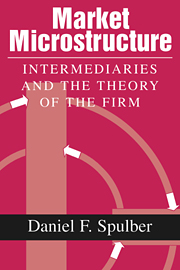Book contents
- Frontmatter
- Contents
- Preface and acknowledgments
- Introduction
- Part I Market microstructure and the intermediation theory of the firm
- Part II Competition and market equilibrium
- Part III Intermediation versus decentralized trade
- Part IV Intermediation under asymmetric information
- Part V Intermediation and transaction-cost theory
- Part VI Intermediation and agency theory
- Conclusion
- References
- Index
Preface and acknowledgments
Published online by Cambridge University Press: 18 December 2009
- Frontmatter
- Contents
- Preface and acknowledgments
- Introduction
- Part I Market microstructure and the intermediation theory of the firm
- Part II Competition and market equilibrium
- Part III Intermediation versus decentralized trade
- Part IV Intermediation under asymmetric information
- Part V Intermediation and transaction-cost theory
- Part VI Intermediation and agency theory
- Conclusion
- References
- Index
Summary
Two fundamental and closely related questions raised by microeconomics are “Why are there firms?” and “How do markets work?” In this book, I set out an intermediation theory of the firm that addresses these two important questions. The intermediation theory of the firm provides explanations for the formation of firms by showing how firms arise in a market equilibrium. In addition, the theory helps explain how markets work by showing how firms select market-clearing prices. Models of intermediation and market microstructure from microeconomics and finance shed considerable light on the formation and market-making activities of firms.
The analysis of firms begins with the observation that firms act as intermediaries between their customers and their suppliers. Without firms, consumers acting as buyers and sellers would engage in direct exchange, searching for each other and bargaining over the terms of trade.
The intermediation theory of the firm can then be summarized: Firms are formed when the gains from intermediated exchange exceed the gains from direct exchange. Intermediated exchange can have advantages over direct exchange for many reasons, which are set forth in this book. These include lowering the costs of transacting through centralization of exchange, reducing costs of searching and bargaining, reducing moral hazard and opportunism, alleviating the effects of adverse selection, allowing buyers and sellers to make credible commitments, and reducing the costs of monitoring performance through delegation.
Resources are allocated through decentralized processes of direct exchange, through centralized exchange managed by intermediaries, or through some combination of the two.
- Type
- Chapter
- Information
- Market MicrostructureIntermediaries and the Theory of the Firm, pp. ix - xiiPublisher: Cambridge University PressPrint publication year: 1999



